#the flight of the winged serpent
Explore tagged Tumblr posts
Note
Is your worldbuilding based off an already created work? (I have a feeling it's not but I'm not great at recognizing fandoms)
Also I want to know more about the worlds referred to in the species descriptions you've posted. Are we talking planets? Realms? Continents? How does travel happen?
All my work is original! I think it's cool that fandom spaces exist but I've never been a big fandom person myself.
I have, mainly, three settings I'm working on, from most recent to oldest: Ostbaye Moon is a sci-fi setting I'm occasionally working on with my husband for a TTRPG project which may or may not eventually come to life. I haven't really posted about it here and I'm not actively working on it at the moment. This setting is set on an habitable moon of a gas giant which is coveted by different alien factions who want to exploit, inhabit, protect it and more. This setting has several planets and stuff implied but is centered on that moon. This setting has some sort of FTL and wormhole tech but it is somewhat unimportant to it.
Pigeon Aéropostale, which I've been posting about recently, is a story set in the fantasy setting of the Endworld / Le Terminal. The Endworld is a planet or a dimension which has a one-way connection to a few other worlds, including ours. When a lot of things die in a small time/space region, there's a chance that at the moment of their death, they will find themselves alive and intact in the Endworld. No one has ever returned to one of the origin worlds from the Endworld - most people in the Endworld were born there, descendants from people who, at some point in the past, materialized from a tragedy in their origin world. The Endworld is planet-sized (whether this is constant or the Endworld is expending is a source of in-world debate), but the story mostly happens in Iscea (Iscée), a country rolling into industrial revolution at full steam in which Sébastie Jayde, illegitimate daughter of a trading magnate, is trying to build the first postal airline out of aviation's first hiccups.
Uanlikri, my oldest (and biggest) setting, is a fantasy setting with no magic whatsoever that I would personally rather describe as a bronze-age sci-fi. There's a lot of anthropological intent to Uanlikri. Uanlikri is one of the continents of the antiole world - the one with the dinosaur guys (there may or may not be antioles in Endworld as well - there were, when I was working on it 10 years ago, but now that I'm working on it again I'm not sure I want to keep them in. Time will tell). Uanlikri is a large continent, slightly smaller than Africa. There are other continents on this planet, but for the sake of my sanity, I'm not touching them except to the extent where people there have active relations with peoples on Uanlikri. Travel on Uanlikri is mostly by foot or by boat. Most of my work on Uanlikri is centered in the Basin region, which I haven't really posted much about because I've been busy working on my "Peoples of Uanlikri" vignettes for the peoples of the South, but suffices to say that the Basin region is a mediterannean-ish theater of empires hitting eachother and themselves on the head over centuries. The Basin region of Uanlikri is home to two stories I hope to write someday, both about the fall of the Namitan Empire, a large polity in the North of the Basin: The Flight of the Winged Serpent, which recounts the life and death of the last Emperor of Namitie, and Empire's Wake, which takes place in the vassal state of the Protectorate of Ranai as the Empire crumbles into civil war after the death of the last Emperor.
#asks#worldbuilding#ostbaye moon#endworld#terminal#pigeon aeropostale#uanlikri#empire's wake#the flight of the winged serpent#Endworld has a lot of cool stuff to it. it's my cool factor setting. it's got magic and shit
9 notes
·
View notes
Text

Hee hee hoo hoo spiralllll

Maroon/Blood/Twilight, Wasp/Bee/Stained
Also bonus shitty doodle of this things body plan

324 notes
·
View notes
Text
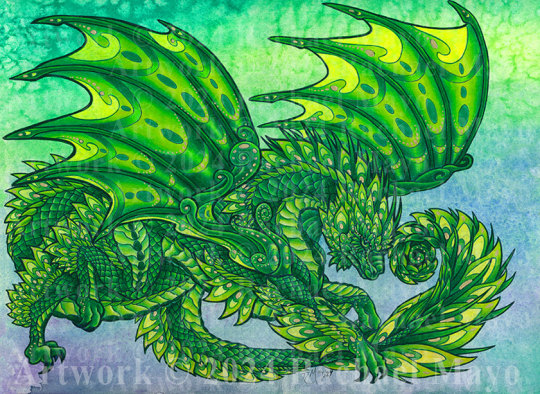
This is still a work-in-progress. Eventually, I will partially cut out the dragon (I like the way the watercolor turned out for this one, so I want to preserve some of it) and put it into a background with 3D embellishments and other fun stuff.
I plan to do a full-body treatment for all of the dragons from the Dragons of Every Dawn and Dragons of the Twilight Dream images; so far only the Rat and the Serpent are in this partly-finished state. I have Dog, Horse, Tiger, and Rabbit inked and watercolored, but I still need to draw the rest of the zodiacal animals.
I made this with watercolor, Prismacolor pencil, and gold paint pen over a watercolor underpainting, over an ink drawing.
#dragon#serpent#reptile#flight#wings#scals#green#traditional art#traditional media#work in progress#wip
25 notes
·
View notes
Text
Here Be Dragons
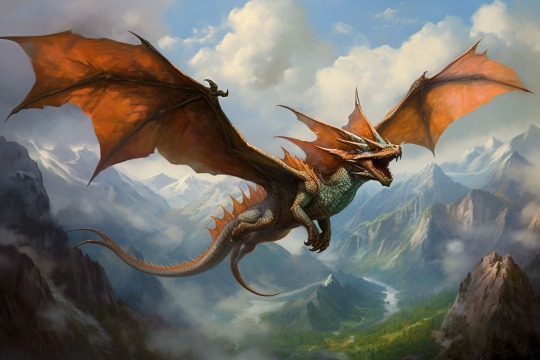
As I gaze upon this majestic tableau, I am transported to a realm where the mountains themselves bow in reverence to the titans that roam the skies. Here, before us, stretches a canvas of the world untamed, a landscape where the clouds whisper secrets to the soaring peaks.
Behold, the dragon! With wings unfurled, a canopy of fiery orange, it commands the heavens. Its scales, a mosaic of emerald and copper, glint like a trove of jewels bestowed upon the earth by the gods of old. This creature, this paragon of might and magic, rides the gusts with the grace of a sovereign without a crown. Its eyes, aglow with the wisdom of eons, survey the world below with a piercing intensity. It is the guardian of mysteries, the keeper of the eternal flame.
In its presence, we are reminded of the tales spun by the hearth—a tapestry of heroes and monsters, of battles fought in the shadow of such titanic beings. This dragon, with horns that aspire to pierce the firmament, is more than a mere beast; it is a symbol of all that is wild and free, a relic from an age when the world was still a map of wonder, waiting to be charted.
As storytellers, we are drawn to these vistas that exist beyond the reach of ordinary life, where our dreams take flight on dragon wings. And so, we commit this image to memory, a reminder of the boundless imagination that dwells within us all, whispering ever so gently, "There be dragons."
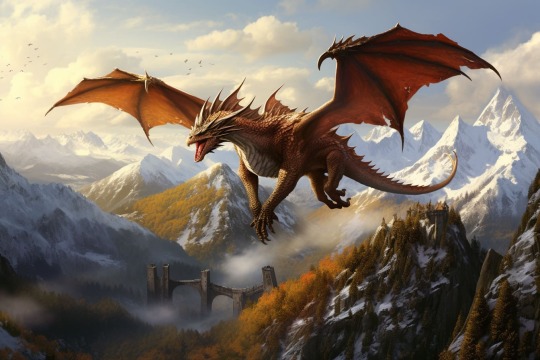
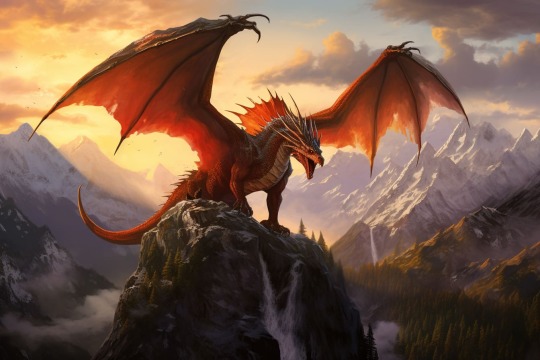
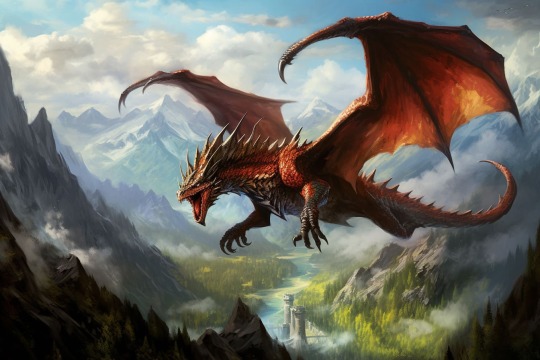
How to draw a dragon head (source: Yonderoo)
#painting#fantasy art#dragon in flight#majestic dragons#mountain realm#mythic creatures#fantasy landscape#winged serpent#epic fantasy#sky titan#dragon lore#ancient guardian#mythical beast#soaring dragon#emerald scales#copper scales#treasure trove#high fantasy#realm of magic#storytelling inspiration#wild and free
5 notes
·
View notes
Text
Lyrics:
child, don't listen to their words you're not a monster no matter what you've heard you're everything i dreamed you'd be a miracle to me they don't get to tell you what you're worth darling, you're native to the night so take these wings i gave you and take flight don't ever be ashamed of your claws, your bite, your strength they don't get to tell you who you are honey, don't ever change a thing your fire breath, your many heads, your poison serpent sting just because they're afraid doesn't mean that you have strayed they don't even get to have a say i can not give you their love but i can make you strong and brave and i can make you tough their swords and arrows cannot pierce the hide of one so proud, so fierce they don't get to tell you who you are they tell you you're a prophecy but you're a possibility they don't get to tell you what to be and let them write their histories clinging to their legacies you and me, we know just what we're worth
326 notes
·
View notes
Text
Sandwing designs

I continue to post my 2 year old art with experiments in WoF dragon designs. Now Sandwings, I made a small variety for them then, but now I would probably make a lot more…
Serpent like. Sandwing ones living in the desert could be quite comfortable moving like snakes. It differs from the canonical appearance only in the shape of the body, the absence of hind legs (the front ones are needed for working with objects) and a modified spine, more elongated. Most likely, in the form of a sinuous snake it would be more convenient to sting.
Sharp-scaled. There are much more spiny scales on the body, like horned lizards. Like them, sandwings can “direct” and “spread” their spikes as a defense, making it more difficult for the enemy to attack in hand-to-hand combat.
Thermoregulating. I’ve had this sand design in my head for a long time, and I think it’s more logical. The dragon's dorsal crest is similar to that of the Spinosaurus, and serves the same purpose - thermoregulation. Sandies can maintain warmth by raising their comb and absorbing the sun's rays, or they can lower their comb/turn to face the heat source and cool down a bit. There are no wings, because… It would be difficult to fly with such a device. Also, their legs would be short and their body elongated in width.
Flat. Once I were inspired with one gif (below) where the dragon had wings like a big veil, and now sandwings are also associated with that veil stretching through the entire body, with a pair of processes supporting the membranes. Dragons could float on air currents or camouflage themselves in large desert areas, placing their entire bodies close to them. And during the flight, the wings would develop like a large blanket in time with the flapping.
That one gif, which inspired me:

by the way, already in 2023 I made art with modified designs of my OCs, using +-same ideas, here is Saxaul (sandwing) and Twilight (rain-nightwing)

#wings of fire#dragon#wings of fire art#wof#wof art#dragon art#illustration#traditional art#traditional drawing#dragon design#design#sand#sandwing#wof sandwing
172 notes
·
View notes
Note
Hi I'm currently writing for a Medusa Themed story, and want the lore for Medusa please
Writing Notes: Medusa
Medusa - (in Greek mythology) the most famous of the monster figures known as Gorgons.
She was usually represented as a winged female creature having a head of hair consisting of snakes.
Unlike the Gorgons, she was sometimes represented as very beautiful.
She was the only Gorgon who was mortal; hence her slayer, Perseus, was able to kill her by cutting off her head.
From the blood that spurted from her neck sprang Chrysaor and Pegasus, her two sons by Poseidon.
The severed head, which had the power of turning into stone all who looked upon it, was given to Athena, who placed it in her shield; according to another account, Perseus buried it in the marketplace of Argos.
Heracles (Hercules) is said to have obtained a lock of Medusa’s hair (which possessed the same powers as the head) from Athena and given it to Sterope, the daughter of Cepheus, as a protection for the town of Tegea against attack; when exposed to view, the lock was supposed to bring on a storm, which put the enemy to flight.
From The Oxford Companion to World Mythology (2005):
Medusa - The only mortal member of the family of horrifying clawed and winged Gorgons, whose heads were covered in serpents.
Medusa began her life as a beautiful young woman.
But the Greek goddess Athena changed her hair into serpents as a punishment for her having defiled her temple by way of a relationship with Poseidon, a relationship that resulted in the birth of the winged horse Pegasus.
Anyone who looked at Medusa would be turned to stone.
This fact plays a role in the story of the hero Perseus.
According to Hesiod in his Theogony, Medusa and her sisters were the sisters of the Graeae and lived "beyond framed Oceanus at the world's hard edge by Night, where the clear-voiced Hesperides are" (Theogony, 270).
The three sisters are often mentioned together, but it is Medusa who is commonly depicted in both ancient Greek literature and art.
The name Gorgon comes from the ancient Greek word γοργός, meaning "grim," "fierce," and "terrible," and Medusa's name derives from the ancient Greek verb μέδω meaning "to guard" or "to protect," which is very fitting given the apotropaic quality of the face of the Gorgon, known as the Gorgoneion.
Medusa in Ancient Greek Art. Medusa is an instantly recognizable figure from ancient Greek art. Her face, whether fierce and grotesque or feminine and composed, appears in virtually all media in varying contexts.
The most common interpretation of Medusa suggests she is an apotropaic symbol used to protect from and ward off the negative, like the modern evil eye.
She represents a dangerous threat meant to deter other dangerous threats, an image of evil to repel evil.
A close look at her role in Greek mythology and art reveals a nuanced and complex character with multiple iterations and implications.
Medusa is best known for having hair made of snakes and for her ability to turn anyone she looked at to stone, literally to petrify.
Multiple works by ancient sources, such as Homer, the eighth-century B.C. poet Hesiod, and the fifth-century B.C. lyric poet Pindar, provide a wide-ranging and diverse picture of the fabled creature.
According to Hesiod’s Theogony, she was one of three Gorgon sisters born to Keto and Phorkys, primordial sea gods; Medusa was mortal, while the others, Stheno and Euryale, were immortal.
The best known myth recounts her fateful encounter with the Greek hero Perseus:
A dishonorable king demanded that he bring him an impossible gift:
the head of Medusa.
Perseus set out with the aid of the gods, who provided him with divine tools.
While the Gorgons slept, the hero attacked, using Athena’s polished shield to view the reflection of Medusa’s awful face and avoid her petrifying gaze while he beheaded her with a harpe, an adamantine sword.
Such a violent act resulted in the birth of Medusa’s children, the winged horse Pegasos and the giant Chrysaor, who sprung from her neck.
The two immortal sisters pursued Perseus with fury, but the hero escaped with his prize using Hermes’ winged boots and Hades’ helmet of invisibility.
Not even death, however, could quell Medusa’s power, and Perseus had to keep her decapitated head in a special sack strong enough to contain it, called a kybisis.
On his travels, he used the head to turn his enemies to stone and rescue the princess Andromeda from a sea monster (20.192.16), before giving it to Athena for her aegis.
Pindar’s Twelfth Pythian Ode recounts how Stheno and Euryale’s angry pursuit of their sister’s killer resulted in another chapter of the Medusa myth:
After hearing their anguished and furious cries, Athena was inspired to invent the flute to mimic them.
When the goddess played the flute, however, she discarded it after seeing her reflection; her face distended and became ugly as she played.
While she purposefully and successfully mimicked the wails of the Gorgons, she also unwittingly imitated their wide and dreadful features.
The snake-haired Medusa does not become widespread until the first century B.C. The Roman author Ovid describes the mortal Medusa as a beautiful maiden seduced by Poseidon in a temple of Athena.
Such a sacrilege attracted the goddess’ wrath, and she punished Medusa by turning her hair to snakes.
While these stories sound fantastical today, to the ancient Greeks they were quasi-historical.
Myths, as well as the stories recorded by Homer and Hesiod, were considered part of a lost heroic past when men and women interacted with heroes, gods, and the supernatural.
Tales from this period were repeated in every medium; the evidence from Greece presents a world saturated with heroes and monsters in poetry, prose, and art.
As such, Medusa was not just a fantastical beast, but part of a shared past and present in the minds of ancient viewers.
She signified a historical menace—the story of Perseus vanquishing and harnessing her energy was not just a story, but a chapter in the shared allegorical and historical record of the Greeks.
Just as Medusa exists in multiple types of stories in the mythological record, she is also portrayed in multiple ways in ancient art.
Her appearance changes drastically through the centuries, but she is always recognizable due to her striking frontality.
It is rare in Greek art for a figure to face directly out, but in almost all representations of Medusa, despite style and medium, she stares ahead and uncompromisingly confronts the viewer.
The term gorgoneion refers to the head and face of Medusa, which was used often as a decorative motif. It is a prolific symbol of her particular power that appears in architecture, vase painting, and metalwork.
Alterity is at the foundation of Medusa’s force, which was alive and present in the minds and memories of ancient viewers. Her very presence is foreign, dangerous, and potent, as are her specific characteristics.
In the Odyssey, her head was kept in Hades to drive the living from the world of the dead.
The Perseus myth provides us with the phenomenon that her face and gaze could turn men to stone. Pindar preserves the tale that the Gorgon’s cries were awesome and awful. Perseus and Athena were required to control such threatening forces and harness their power.
This harness was taken up by ancient Greek artists, who represented the Gorgon across all periods and in all media.
Medusa is a deadly and cryptic other, but she is also ubiquitous, with an undeniable energy that inspired artists to repeat her semblance and story in diverse ways across literature, lore, and art through ancient Greece, Rome, and beyond.
Sources: 1 2 3 4 5 ⚜ More: References ⚜ Writing Resources PDFs
Excerpts from "The Library of Greek Mythology" by Apollodorus of Athens: 1 2 ⚜ Some Medusa-related art
You can also find more information in the sources linked above. Hope this helps with your story!
#medusa#greek mythology#writeblr#literature#writers on tumblr#writing reference#dark academia#spilled ink#writing prompt#creative writing#light academia#writing inspiration#writing ideas#writing resources
58 notes
·
View notes
Text
The Crawfordsville Monster [modern cryptid; urban legend]
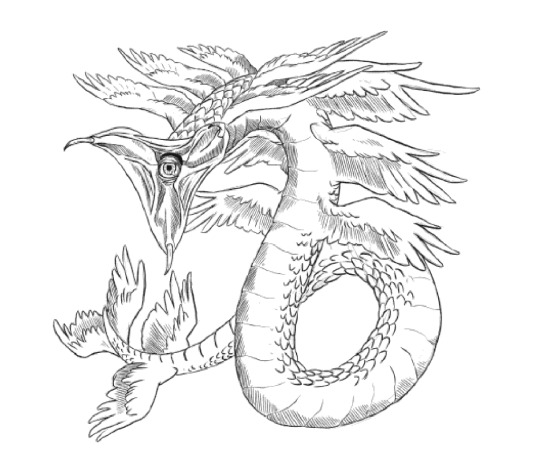
As far as modern urban legends go, most sightings of cryptids and creatures tend to fall into one of several recognizable categories: a lake monster, a flying saucer, an ape-like creature, etc. But every once in a while you have something weirder or unique:
On April 5, 1891, a supposed monster was sighted in the skies above Crawfordsville, Indiana, in the USA. A local pastor, Reverend G. Switzer, left his house to get some water from the well in his backyard when he supposedly experienced a strange feeling somewhere between dread and awe. Uncertain what caused this feeling, he looked up to see a large serpent-like being flying through the sky. The snake moved quickly even though there was no wind that night, and seemed like it was about to land, only to change its mind and take off again.
The paster and his wife were not the only witnesses, for that same day the apparition was seen by two workers about to haul ice on their wagon. They were so frightened of the creature that they took shelter until it was out of sight.
The size of the creature varies between stories, putting it somewhere between 16 and 20 feet (5 à 6 meters). It did not have wings – although other accounts added several fins or fin-like structures – but was able to fly by means of writhing movements, not unlike those of a real snake. The monster was white and had no head, or at least no clearly visible head, but it did have a large, brightly burning eye. Despite the lack of a visible head or mouth, the monster emitted a wheezing noise.
The Crawfordsville Daily Journal named the creature ‘the Midnight Wraith’ but today it is more commonly referred to as 'the Crawfordsville Monster'.

When researching this sighting, I came across some very weird UFO theories. While they tend to strain credibility, I admit that it’s fun to theorize about, in a fantasy worldbuilding kind of way. For example, the last source I listed here mentions a theory about atmospheric creatures that live in the clouds of our planet and stay afloat because of their extremely low-density bodies. The Crawfordsville monster, supposedly, could be such a creature.
Several explanations have been put forth. Some claimed it was a spirit. Professor Robert Burton assumed that the witnesses might simply have been under influence of alcohol or drugs. A later sighting in the same location put forth a simpler, albeit anticlimactic, explanation: two men followed the flying ‘monster’ around until it came close enough for them to identify it as a giant flock of killdeer birds: local birds with a distinct white belly. There were several hundred of them in the flock, and the birds’ erratic flight pattern might have been caused by their confusion from the electric lights, and the many moving ‘fins’ of the monster would have been the wings of the different birds. Perhaps exhaustion in the early hour, combined with the dark night sky, caused the ice haulers and the pastor to mistake the flock for a monster.
Sources: Clark, J., 2005, Unnatural Phenomena: A Guide to the Bizarre Wonders of North America, Bloomsbury Publishing USA, 408 pp., 160 pp., p. 87-88. Zach, K. B., 2003, Crawfordsville, Athens of Indiana, Arcadia Publishing, p. 140-141. Hunt, C. M., 2023, Ghosts & Legends of Crawfordsville, Indiana. Haunted America, Arcadia Publishing, 160 pp., p. 12-18.
(image source 1: Mart, T.S. & Cabre, M., 2021, A Guide To Sky Monsters : Thunderbirds, The Jersey Devil, Mothman, and Other Flying Cryptids, Indiana University Press, 174 pp.) (image source: Enshohma on Deviantart)
#urban legends#cryptids#creatures#monsters#American mythology#if you can call urban legends 'mythology'#mythical creatures
129 notes
·
View notes
Text
SO I was inspired by This Reblog and absolutely adore any and all dragon Aus. And was hit with a rapid bit of inspiration.
Danny sighed through his nose, rolling his shoulders as another blob coiled across his arm like a serpent. It was an interesting thing, how they mimicked other forms, though he didn't understand all of it.
Normally they wouldn't mimic him so much, not so strongly at least. But well, the ghosts here were mere whispers, visible to a few and unable to interact much. Which is what really brought him here in the first place.
Apparently something is blocking the access to the Realms here, enough that someone needs to do something about it. And look, he's not the Ghost King (thank fuck, he'd never be able to have Star-Time if he was) but he does sort of have a job to do. As the child of Time and new Ancient of Space to-be.
Not to mention that as said new Ancient-of-Space-to-be the Observants can't complain that much about him entering a world they didn't like.
And oh boy, this world. Yikes. There's some corrupted stuff freaking everywhere (even if not visibly), and monsters. And he does mean monsters, a lot of these things are corrupted as all heck- though thankfully the skeletal undead ones leave him alone no matter what form he takes.
On the other hand? There's this little gremlin child that reminds him of Ellie that runs into him repeatedly. Danny is starting to think it's on purpose actually. Child? Child where are your caretakers, you can't just charge at the lion-horse people- ... Danny despises prophecies. Alright child, he's going to start following you because you haven't even eaten tonight apparently. And your weapon has broken. Twice. And you're apparently surrounded by ghosts, how has he not noticed- alright. OKAY. This is fine.
-------------------------
Link, would like everyone to know, that he is actually having so much fun right now! There's this sort-of Hylian that he found when looking for Koroks whose sort of like a stal-hylian? Or something? But they're nice!
And they have wings! He thought it was some sort of cloak at first, but no, they're full on wings! And he's going to convince them to take him flying. He will.
After he takes care of this itching on his back, because it's getting really distracting...
Yes I used Flight Rising specifically because @fairy-lights-and-blobs mentioned it specifically for Danny's wings.


A Danny & Link <3 But also feel free to imagine them as mixed with any dragon really.
#DPxLOZ#DP x loz#legend of zelda crossover#danny phantom crossover#dragon danny#prompts#No joke somewhere I have a story I never posted/finished of dragon Link from when BotW First came out#You know how we have amity getting liminal?#I am just saying Link is probably at least a little liminal#What with the reincarnation & near-death & revival-healing & ghosts#And the fact he can use some abilities from said ghosts#Look Link also deserves to be dragon boi#Even if he's still hylian-dragon probably#Danny went Dad Mode within the first 3 meetings with Link#The Blobs being natural filters are helping with the corruption going on#go wild#Also Danny deserves to be some sort of cryptid to everyone not Link#Like uncanny valley but also I mean#He's practically a space dragon god lol
150 notes
·
View notes
Text
Devotional Poem for Phobos and Deimos

Deimos, and Phobos, shield-breakers who walk with the Keres, Twins of Queen Kytherea and her bloody Lord Ares, who arm themselves with terror. Oath-abandoning beasts, who compel disciplined warriors to flee. Riders of vile chariot, destroyers of men, lionlike dealers of death. Allies of Eris, who frenzy wives at wartime, and drive conspirators to act. Companions, beloved sons of Miaiphonos, his company in battle. Sweet children of Areia, who attend their mother in the sewn strife of affairs. Brothers of Harmonia and the Erotes, whose tastes sway them not. Double serpents who taste the sweetness of nectar in the blood of men. I lay upon you my own weapons, my sharpened eyes, and tongue, my hot-beating heart. With praise, I call upon you, who pray on the waiting and watching. Deimos, dreadful one, who sits in darkness and invokes the tension of bodies. Phobos, terrorizer, who rushes to swell minds with horrors- and gives wing to flight. Ensnare me not, instead sit beside me. Twins who guide hearts to act with paralyzing after-taste, I lay upon you laurels of my own, immaterial arts of your mothers, Gifts born of passion and love, to satiate and calm.
#hellenic polythiest#hellenic polytheism#deimos#phobos#deimos and phobos#phobos and deimos#greek gods#ares deity#aphrodite priestess#hiereia
31 notes
·
View notes
Text

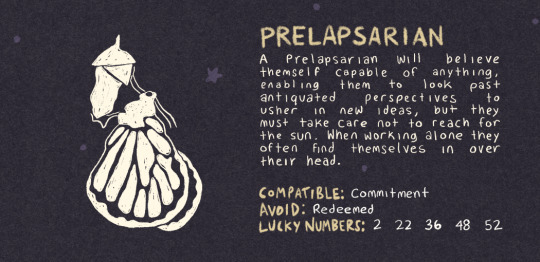


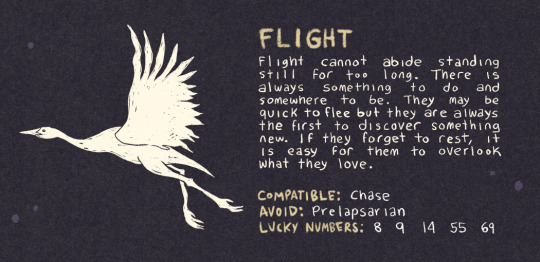

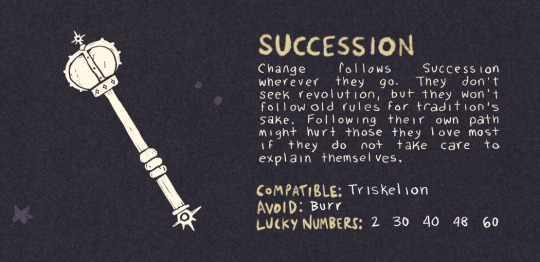
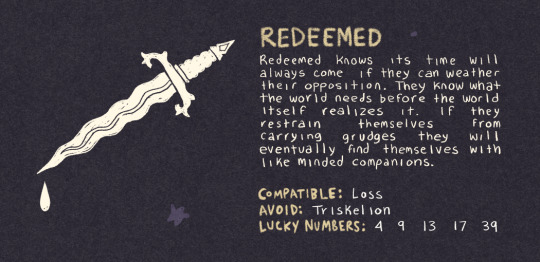

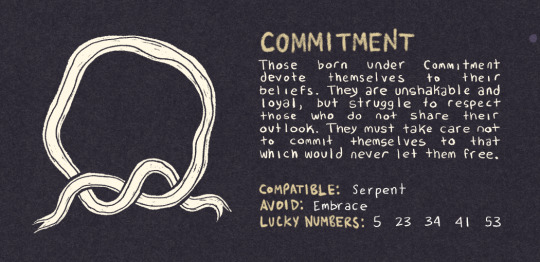


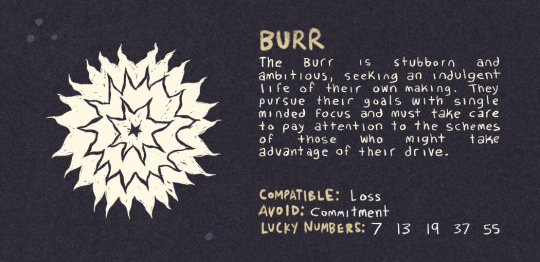
Constellations from our group's game of The Prophet's Path for our campaign, Post Solar. Transcriptions of the text plus the image of the star map are under the cut:

Prelapsarian: A Prelapsarian will believe themself capable of anything, enabling them to look past antiquated perspectives to usher in new ideas, but they must take care not to reach for the sun. When working alone they often find themselves in over their head.
Compatible: Commitment Avoid: Redeemed Lucky Numbers: 2, 22, 36, 48, 52 Notable figures: Stele of the Compassion, Jack of Guts, Eschaton Elegy
Embrace: Embrace wants nothing more than to keep the world safe in its arms. They make noble leaders who will devote themselves to building a more just world, sometimes at the cost of their own happiness. A too tight Embrace is painful for everyone involved.
Compatible: Harlequin Avoid: Prelapsarian Lucky Numbers: 4, 8, 10, 12, 44 Notable Figures: Mercadier de Nulle, Mortis of the Blood, Anthem Rebis, Oranges-for-Breakfast
Chase: Children born in the grip of the Chase are masters of their field. They seek to endlessly improve at their chosen work, but they never forget to have a bit of fun in the process. Other Constellations may mistake gaiety for a lack of responsibility if the Chase mixes work and play.
Compatible: Prelapsarian Avoid: Succession Lucky Numbers: 6, 22, 33, 44, 66 Notable Figures: Juni of the Compassion, Abacus the Weasel, Dr. Temple Shrine, The Prophet's Sister
Flight: Flight cannot abide standing still for too long. There is always something to do and somewhere to be. They may be quick to flee but they are always the first to discover something new. If they forget to rest, it is easy for them to overlook what they love.
Compatible: Chase Avoid: Prelapsarian Lucky Numbers: 8, 9, 14, 55, 69 Notable Figures: Conifer of the Miracle, Captain Ache, Wing and a Prayer
Harlequin: The Harlequin has a pronounced sense of duty that allows them to patiently pursue their goals. While they are often a gregarious Constellation, they are not good communicators. They must learn to choose their words carefully to avoid misunderstandings.
Compatible: Embrace Avoid: Chase Lucky Numbers: 1, 3, 4, 16, 18 Notable Figures: Hart, The Miracle, Cardinal Meridian
Succession: Change follows Succession wherever they go. They don’t seek revolution, but they won’t follow old rules for tradition’s sake. Following their own path might hurt those they love most if they do not take care to explain themselves.
Compatible: Triskelion Avoid: Burr Lucky Numbers: 24, 30, 40, 48, 60 Notable Figures: Jori, Captain Montmercy, Mourning, Glory
Redeemed: Redeemed knows its time will always come, if they can weather their opposition. They know what the world needs before the world itself realizes it. If they restrain themselves from carrying grudges they will eventually find themselves with like minded companions.
Compatible: Loss Avoid: Triskelion Lucky Numbers: 4, 9, 13, 17, 39 Notable Figures: Juri of the Compassion, Syllophane
Triskelion: The Triskelion is known for its wicked heart, but it is not doomed to tyranny. The Triskelion is three hearts made one: the traitor, the lover, and the lost. If they can find balance between their natures, their heart will allow them to achieve many noble deeds in the face of disbelief.
Compatible: Flight Avoid: Serpent Lucky Numbers: 3, 4, 21, 30, 52 Notable Figures: Jaci of the Compassion, Old Bones
Commitment: Those born under Commitment devote themselves to their beliefs. They are unshakable and loyal, but struggle to respect those who do not share their outlook. They must take care not to commit themselves to that which would never let them free.
Compatible: Serpent Avoid: Embrace Lucky Numbers: 5, 23, 34, 41, 53 Notable Figures: The Lost Angel, Solstice Sixtine, Joli of the Compassion
Serpent: The most mutable of the Constellations, the playful Serpents desire companionship and warmth. They trust those in their embrace to always have their best interests at heart. When that trust is broken, they repay the deepest wounds with the sharpest bite.
Compatible: Serpent Avoid: Loss Lucky Numbers: 2, 8, 15, 38, 65 Notable Figures: Hercif of the Miracle, Hercun of the Miracle, Estell Manor
Loss: Those born under the sign of Loss start the world with nothing, but they have everything to gain. The children of Loss will do anything to obtain more than the Constellations ever dreamed of achieving. A Loss is never a setback: it can only sharpen their desire.
Compatible: Harlequin Avoid: Loss Lucky Numbers: 0, 1, 31, 68, 70 Notable Figures: For Felinus, Valentine Egress, Lorelei, The Prophet, Kotowari
Burr: The Burr is stubborn and ambitious, seeking an indulgent life of their own making. They pursue their goals with single minded focus and must take care to pay attention to the schemes of those who might take advantage of their drive.
Compatible: Loss Avoid: Commitment Lucky Numbers: 7, 13, 19, 37, 55 Notable Figures: Iola, Sophia, Captain Hardwood, King Burr, Errol Clay Frick
120 notes
·
View notes
Text



Golden Wand of the Magi Talon Abraxas “Here we see his full power of transcendence, whereby the lower transcendence from underworld snake-consciousness, passing through the medium of earthly reality, finally attains transcendence to superhuman or transpersonal reality in its winged flight.” Hermes and Aesculapius If you’ve ever been to a hospital or flipped through a phone book looking up a physician, you’ve seen the image: two serpents criss-crossed around a staff topped by a round knob and flanked by wings. This is known as the caduceus, and it has been the symbol of the American medical profession for nearly a hundred years – a decidedly odd symbol for doctors, until you begin to investigate its underlying meanings.
According to Walter Friedlander, in The Golden Wand of Medicine: A History of the Caduceus Symbol in Medicine, this connection can be traced back to 1902, when the U.S. Army adopted the caduceus as the insignia of its Medical Corps, which had previously used the cross. Earlier, in the 16th and 17th centuries, the caduceus had been used by printers because it was the staff of Hermes (Mercury) the messenger god, and hence the divine deliverer of information. In the 19th century, a medical publisher used the symbol prominently on its texts, and thereby began the association of the caduceus with medicine, an association made firm by the prevalence of the image in the American Medical Corps during World War I. A symbol first representative of wisdom, eloquence, and communication, thus became the common logo for those in the health profession.
Citing the history of the caduceus, some physicians are critical of the symbol, because Hermes also happens to be the god that leads the dead to the underworld and is not only associated with wealth and commerce, but happens to be the patron of thieves (he is a classic trickster figure in Greek myths). It only makes sense that doctors wouldn’t want to be associated with trickery, death, and the accumulation of wealth! Medical purists suggest we should go back to the staff of Aesculapius, which is depicted as a single serpent coiled around a cypress branch.
The story of Aesculapius and his association with Hermes begins to make the story of the related symbols quite interesting. According to Greek myth, the god Apollo, in a fit of jealousy, killed his unfaithful mortal lover, a woman named Coronis (the Greek root of her name, korone, refers to a seabird, or a crow). When Apollo discovered that she was pregnant with his son, he had Hermes deliver the child while her body lay on the funeral pyre. The child was none other than Aesculapius.
Aesculapius was trained by the wise centaur, Chiron, to become a healer (since his father, Apollo, was the god of health), and over time, he became the god of medicine with his own cult and temples. Hippocrates, regarded as the father of western medicine, was a 20th-generation member of the cult of Aesculapius.
There are various explanations for why Aesculapius’s symbol is the serpent coiled around a staff. The figurative interpretations consider the symbology (the snake’s association with rebirth, the cypress branch as representing strength); and the utilitarian approach suggests that the snake was a poisonous one tied to the staff, its venom used for its medical properties. But the fact that Hermes was Aesculapius’s deliverer does not quite explain how the messenger god ended up with the symbol for medicine or why the serpents were doubled (though the wings might be explained as a displacement of Hermes/Mercury’s winged ankles).
What I’ve presented might seem an adequate (though incomplete) explanation of the caduceus. But as it is with most symbols from antiquity – regardless of how accurately they have retained their original meanings – the possible truth is far more complex, and to explore it is to go into that interstitial space where folklore, religion, myth, and even science begin to lose their boundaries.
The Tree and the Winged Serpent From a purely folkloric angle, it is impossible to ignore an odd fact that one finds in nearly every culture and throughout history: not only are staffs and serpents generally associated, but the juxtaposition or combination of the serpent and the bird symbols is almost always profoundly meaningful. That meaning, except in rare exceptions (which actually seem to prove the rule) is always positive, associated with healing, wisdom, and transcendence. The symbol of serpent and bird is typically reserved for powerful mythic figures, humans of unusual distinction (like shamans and mystics), or for royalty, who are often considered of divine origin.
First, consider some of the connections between the serpent and the staff or rod – those that go beyond the predictable explanation that a rod looks like a rigid serpent. In the Old Testament, during the exodus from Egypt (Numbers 21), Moses is told by God to construct a fiery serpent of brass and to display it on a pole so that those who had been bitten by poisonous snakes would be healed by gazing upon it. In the Gospel of John (John 3:14), we find this particular serpent image recalled in relation to Christ: “And as Moses lifted up the serpent in the wilderness, even so must the Son of man be lifted up.” This allusion not only makes the serpent potentially divine like Christ, but it associates Christ with the serpent (something quite common in Gnostic texts, as I discussed in “The Binary Serpent”). Earlier, in Sumerian and Akkadian representations of the axis mundi (the axis on which the world spins), one finds a pair of serpents criss-crossed over the rod. In Teutonic myth, Odin’s universe is supported by Yggdrasil, “The World Ash.” At the top of this cosmic tree is an eagle, and in its roots is the great cosmic serpent, Nidhogg, who will devour the bones of humanity after the great fall. In Buddhist folklore, the Buddha once meditated under the tree of the serpent king. When a rainstorm threatened to get the Buddha wet, a giant cobra wrapped himself around the Buddha’s body seven times and opened his great hood over the Buddha’s head to keep him dry.
The bird seems already integral to the serpent and rod equation, and it becomes more prominent in other symbology, eventually becoming combined with the serpent. The origin of Kungfu (which is not only martial, but therapeutic and healing), refers to a folktale about a Buddhist monk (or, in some versions, a nun) who observed a crane fighting a snake and designed exercises to emulate their motions. In Sumerian and Babylonian iconography, the gods are often represented by winged disks and figures who are half human and half snake. Egyptian creation myths refer to a serpent and a primordial egg, which contained a bird of light. The Pharaohs of unified Egypt wore the trademark double crown of Horus and Set, represented by the vulture and the cobra. The serpent coiled on the foreheads of the Pharaohs represented divine fire, which originated at the base of the spine and ascended it just as the serpent had crawled up the Tree of Life. In Sanskrit, the coiled serpent is used to represent Kundalini, the energy that rises from the sacrum – the bone at the base of the spine – and results in enlightenment when it properly reaches the crown of the head through the practice of Kundalini yoga, which channels the energy along the six chakras, or energy centers, that correspond to the number of intersections of the serpent on the caduceus. Literally, Kundalini means “The Serpent Power.”
Among Egyptian hieroglyphs, one finds a prominent winged serpent, which some say is a precursor of the most famous of winged serpents, the Mesoamerican feathered serpent, Quetzalcoatl, known also as Kulkulcan. Like the Egyptian Pharaoh, Akhanaten, Quetzalcoatl declared that there was only one god, and he did away with earlier forms of sacrifice; he was a healer and a scientist, and he could take on human form. (One of history’s great ironies is how the Conquistadors took advantage of the story of Quetzalcoatl’s return to destroy a civilization.)
From a feathered serpent, it is easy to make the next association to a serpent that flies, namely the figure of the dragon (the Greek drakon, which means “serpent”). In the lore of the British Isles, the most prominent dragon is, of course, the mythic king Arthur Pendragon. In Chinese cosmology, there are four Ao, or Dragon Kings (Qin, Kuang, Jun and Xun), each with his own elemental domain. In Korean legend, virtuous serpents eventually become dragons when rising into heaven, ascending a rainbow.
The rainbow itself is a profound symbol, though here we can consider its quality of being like the colored ribbons associated with the maypole dance or the colored ribbons on the original caduceus (which also find expression in the red, white, and blue lines on the traditional barber’s pole). The rainbow is also associated with flight and presents a wing-like quality when it is bisected. In the tradition of Voodoo, one finds prominent connections between rainbow and serpent; among the Australian Aborigines, the rainbow serpent (with a host of different names, depending on language and region), is the most important figure in the Dreamtime. According to some variants of the Dreamtime myths, it is the primary creator of geological features that linger in the mundane world.
When the symbol of the caduceus is stylized and simplified, it creates another set of linked associations. For decades, anthropologists have tried to decipher the meaning of the symbol found among the ruins of Minoan Crete (one of the primary sources of Greek civilization). This symbol, called the labrys, is often called a double-headed axe because it resembles one.
Feminists have reinterpreted it, given the Minoan culture, to represent the wings of a butterfly spread at the top of a rod (which might represent a caterpillar); it is read now as a symbol of transformation and transcendence, which makes it parallel to the caduceus; but scholars have not yet realized that it is, in fact, a simplified caduceus. Less sophisticated renditions of the labrys scratched onto stones and walls look like a sideways hourglass on top of a line.
Likewise, in a more modern context, we tend to take the familiar pharmacists’s logo to be an overlapping R and X, when, in fact, it is a skewed rendition of the Greek letters Chi (X) and Ro (P), which are actually a representation of Christ (Chi and Ro being the first two letters in his name). The pharmacist’s ChiRo is an invocation of Christ’s healing power, just as the ChiRo in Chiropracty (in case you’ve wondered) is a reference to Christ. The Chi and Ro used in Christian iconography look remarkably similar to the simplified labrys, though the connection may seem forced until one examines the symbology of Christ on the cross.
When the serpent and the bird are forcefully separated, they tend to take on opposite and antagonistic meanings. A good example of this phenomenon is what happens in Genesis, when the serpent is demonized as Satan and the tree of life is taboo. This contrasts with the story of the flood in which the white bird (the dove) bringing back the olive branch is associated with salvation as it finds the place for Noah to land (and note the use of the rainbow symbol as a promise from God never again to flood the earth).
In the New Testament, the dove represents the Holy Spirit who, in Catholic symbology, is part of the Trinity. Since I’ve already pointed out how Christ has been equated with the serpent, suffice it to say that if God, Christ, and the Holy Spirit are one and the same according to the doctrine of the Trinity, then the Catholic crucifix is implicitly a caduceus as well: the cross is the staff, and Christ is simultaneously serpent and bird. And the knob at the top of the caduceus? On the crucifix, that is implied by the presence of God, though it is ironically inhibited by the crown of thorns.
28 notes
·
View notes
Text
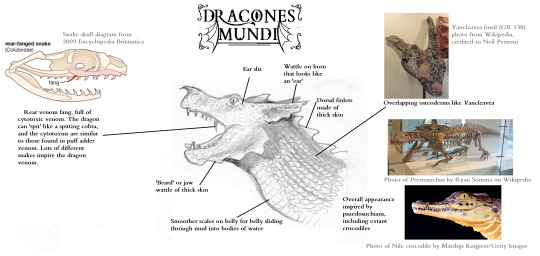
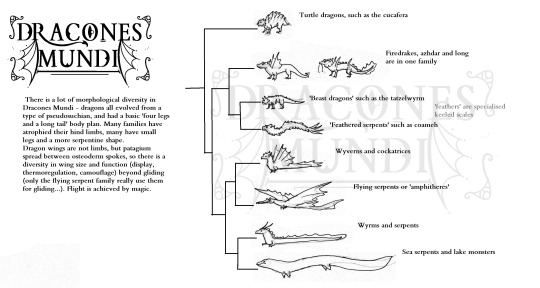
Dracones Mundi infographics to explain some of the dragon design features in my project :3
Image IDs in alt text or below the cut:
A labelled diagram depicting a dragon’s head. Labels are: ear slit. Wattle on horn that looks like an ‘ear’. Dorsal finlets made of thick skin. Overlapping osteoderms like Vancleavea (accompanied by Vancleavea fossil photo). Overall appearance inspired by pseuedosuchians, including extant crocodiles (accompanied by skeletal mount of Prestosuchus and a photo of a baby Nile crocodile). Smoother scales on belly for sliding though mud into bodies of water. ‘Beard’ or jaw wattle of thick skin. Rear venom fang, full of cytotoxic venom. The dragon can ‘spit’ like a spitting cobra, and the cytotoxins are similar to those found in puff adder venom. Lots of different snakes inspire dragon venom (accompanied by diagram of snake skull).
A dragon family tree accompanied by a paragraph of text. Text reads: There is a lot of morphological diversity in Dracones Mundi – dragons all evolved from a type of pseudosuchian, and had a basic ‘four legs and a long tail' body plan. Many families have atrophied their hind limbs, many have small legs and more serpentine shape. Dragon wings are not limbs, but patagium spread between osteoderm spokes, so there is a diversity in wing size and function (display, thermoregulation, camouflage) beyond gliding (only the flying serpent family really use them for gliding…). Flight is achieved by magic.
The dragons on the family tree are: turtle dragons, such as the cucafera. Firedrakes, azhdar and long are in one family. ‘Beast dragons’ such as the tatzelwyrm. ‘Feathered serpents’ such as coameh. Wyverns and cockatrices. Flying serpents or ‘amphitheres’. Wyrms and serpents. Sea serpents and lake monsters.
151 notes
·
View notes
Note
(ShayminCafe) Shaymes approached the large serpent with caution, taking flight into the air to account for their large size difference. Spreading his wings as wide as he could whilst in flight, Shaymes bowed before Vourison. "Blessings be upon you and your kin," he said. "Have you come to seek the blessings of the Magi? Perhaps invite them to pass some good fortune upon your friends and kin?"
"Ah. Hello." Vourison said awkwardly, not expecting the sudden question. "Seeing the Magi would be interesting I suppose, but it's not really what I'm here for. I mean, I'm mostly here because my family wanted to come and dragged me along for the ride."
He gestured towards where Loraifon was bouncing around, "Everyone else is pretty excited to meet them though. This is my first time being on the island myself, but they've been to this festival multiple times."

"What about yourself, any specific reason you came here?"
#pokeask#pokemon ask blog#pokeaskmagiretreat25#pokeask-magi-retreat#pokemon art#vourison rayquaza#ShayminCafe
20 notes
·
View notes
Text
here is a post with the lyrics for every song from lullabies for the wild side! (thanks to alli @operationslipperypuppet for transcribing half of these)
Serpent’s Serenade child, don't listen to their words you're not a monster no matter what you've heard you're everything i dreamed you'd be a miracle to me they don't get to tell you what you're worth
darling, you're native to the night so take these wings i gave you and take flight don't ever be ashamed of your claws, your bite, your strength they don't get to tell you who you are
honey, don't ever change a thing your fire breath, your many heads, your poison serpent sting just because they're afraid doesn't mean that you have strayed they don't even get to have a say
i can not give you their love but i can make you strong and brave and i can make you tough their swords and arrows cannot pierce the hide of one so proud, so fierce they don't get to tell you who you are
they tell you you're a prophecy but you're a possibility they don't get to tell you what to be and let them write their histories clinging to their legacies you and me, we know just what we're worth
The Moon’s Elegy Oh, how I love you, though you’ll never know. Anywhere I go I’m in your shadow. No, I will never find the nerve to broach, anywhere you go I will follow.
‘Cause we share a sky but I still can’t seem to catch your eye. And try as I might, I’m a pale reflection of your light. I tied my life to your chariot of fire— why? Oh, why?
And the prettiest nights are the ones I cry the most, teardrops turn to stars and start to glow. And an endless chase of your golden blaze I go, hiding just behind but all alone.
Cause we share a sky but I still can’t seem to catch your eye, and try as I might, I’m forever half a day behind. I crave your light like a moth to the fire— why? Oh, why?
And you burning brightly and me so blue, how can I get close to you? And you with your fire and me with my gloom, what’s a moon supposed to do when everyone wants to be with you? That’s why I’m so blue.
Ballad of a Green Knight Darling I can’t see you anymore, I’m afraid they’ve summoned me to war. Promises I have made to the Queen and to the Fae, and I intend to keep ‘em with my sword.
Darling if I never make it home to you I’ll visit you as butterflies and dew. In another place and time, I swear I would have made you mine But I have got a duty to strike true.
Green though I be, remember me, and who I could have been if we lived in peace. Married my blade to the fate of the Fae, traded my days for honor and fame.
Green be my steel, be my bow, be my shield, Pledged to defend the vine and the hedge. Remember me when the leaves, and the breeze, and the trees start to tease the first breath of spring.
I would’ve loved to pledge myself to you, but that is not the world that I was born into. A knight is always forged in the crucible of war, And that is what I gave my word to do.
So I will fight with all my verdant might, the blight of night will never dim my light. Though the memory of you makes me turn a shade of blue, a Green Knight has a duty to the Wild.
Green from my head, to my toes, ‘till my death Pledged to protect the vine and the hedge. Green is my blood, I’m sorry my love, remember us after I’m gone.
Oh, that I could be in love and be good, But I made an oath to the fields and the wood. So think of us all when the snow starts to fall, and though we may fall, the order lives on.
Darling, in another place and time I’d have been content to make you mine. And in the dream of death, I’ll dream the life I could have had if I hadn’t pledged myself to hedge and vine.
A Gloaming Lullabye In the gloaming of the night court, the queen calls you to sleep, she blankets you with moonbeams, she beckons you with dreams. So surrender to her majesty, and heed the queen’s decree, she’ll swaddle you in starlight and beguile you with peace.
So meet me in your dreams and we will never be apart. I promise I will find you in the shadows and the dark. The day is gone, the nights are long, and this is just the start. So meet me in between the moon, the galaxies, and stars.
As the scene begins to set, the queen collects her debts. She comes to you with heavy lids to tuck you into bed. As the day turns into night, the queen demands a tithe, you cannot run, you cannot hide, but you can close your eyes.
So meet me in your dreams and we will dance across the sky, a minuet, our heart’s duet, a tango improvised. And who’s to say what lays in wait when day turns into night, so look for me in your dreams, I promise so will I.
And when the sun returns, we’ll savor all we learned; the tutelage of dreams, the alchemy of sleep. And if we spent our dreams in pleasant company, then you will wake in harmony.
So meet me in your dreams, cause I can’t get enough of you. I’ll climb the stars, I’ll scale the moon, there’s nothing I won’t do. And when we meet in sleep so deep, I think that you will find, the day is nice, but nothing beats the night. The days are nice but, oh my god, the nights.
Winter’s Mantle Winter’s Mantle, heavy with fur and snow Icy, still, until the north wind blows Frost on the panes, darkness pervades, rest my pretty babe
Flowers grown shy, dirges and lullabies
Rest, my darling, there’s no work to do Sleep, my child, night is calling you
Sunlight estranged, darkness remains, rest my pretty babe Flowers grown shy, dirges and lullabies
The Giant’s Lover gather round the giantess, beaming with tale to tell listen as she weaves her web of a lover that did excel, small though he was, the way that he loved was enormous stature be damned, he was two times the man that a giant was
met him down in irondeep, sailor of sky and sheet navigated expertly her every last giant need never before had a lover performed like this tour de force titans and ogres rendered mediocre by this tall dwarf
small folk, big fun, sure-foot, hard-won giant lover like no other thick of quad, colossal heart, his size belies a huge surprise
so she waits by window side, dreaming of his return never to be satisfied, inside her his memory burns smallfolk take heed, this tall dwarf has pleased with enormity a small folk she met but a titan she wept for when hardwon left
#naddpod#ba2mia#technically? technically it's ba2mia#emily axford#naddmusic tag#is the punctuation/capitalization on these consistent? no.#am i fixing it? no.
53 notes
·
View notes
Note
As a nature flight member and light flight snob hater I am so vindicated that we got the esoteric many-winged serpent angel dragon with awesome lore and light flight gets the bugs. And I really like the bugs but just, lmao. As soon as I saw them I knew this would be the reaction
24 notes
·
View notes